You are here
Zion National Park Overview | Kolob Canyons and Kolob Terrace | Zion Canyon and Zion Narrows | Zion-Mount Carmel Highway and East Canyons | Camping and Lodging | Wilderness Reservations and Permits | Weather and Flash Floods | Shuttles | Pets
Zion National Park Overview
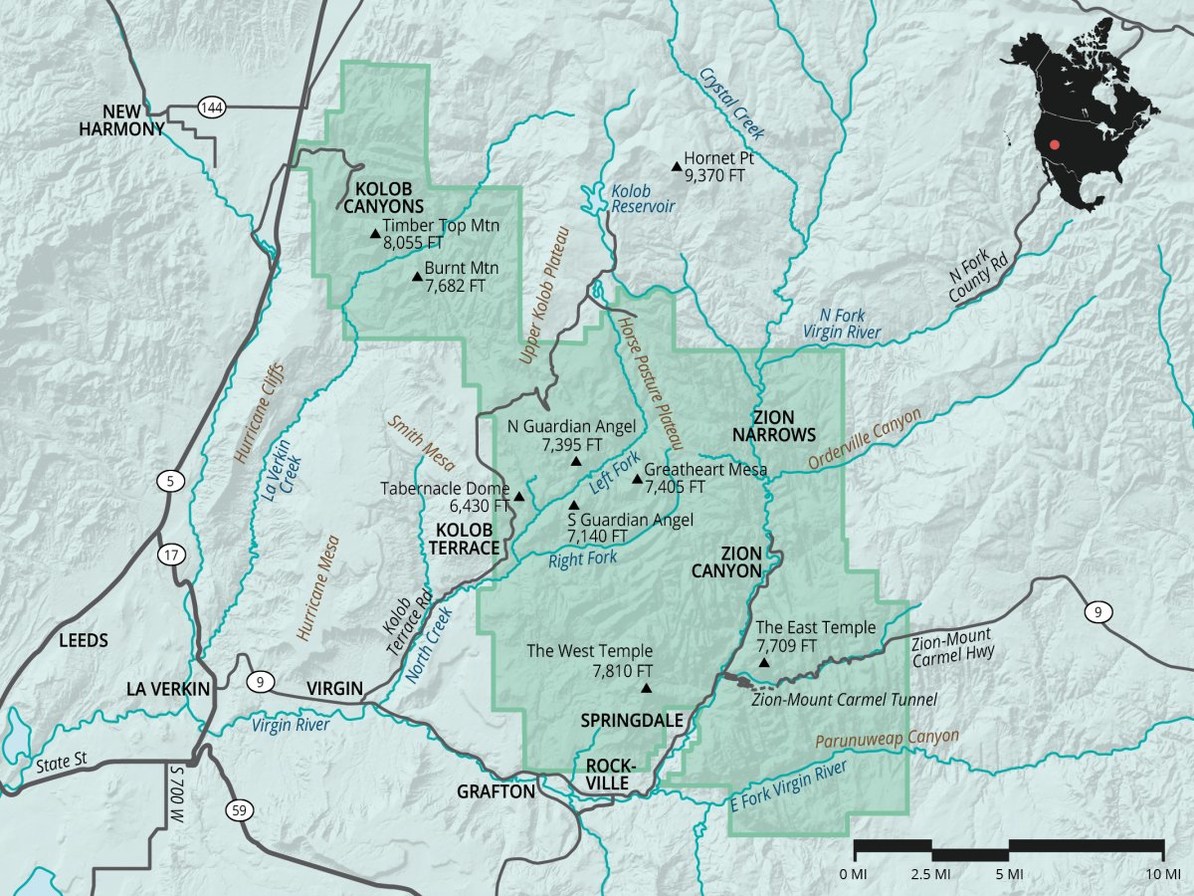
Located in Southwest Utah’s high plateau, Zion National Park’s 229 square miles showcase immense canyon walls, towering sandstone edifices, elegantly eroded canyons, and a uniquely diverse natural habitat that forms some of America’s most unusual landscapes. The scale of the park’s formations must be experienced to be fully appreciated; words and images cannot capture the mix of trepidation and awe that sets in as you walk along a narrow rock spine above a vertiginous canyon, or the sensory confusion you’ll experience as you stand in a narrow gorge between sheer 2,000-foot walls that are only 20 feet apart.
Approximately 3.5 million people travel through Zion annually to experience these and other wonders firsthand, making it the nation’s seventh most visited national park. For day hikers, bikers, rock climbers, backpackers, canyoneers, photographers, and explorers of all ages and abilities, Zion is a wonderland. While Zion Canyon, The Narrows, and the Zion-Mt. Carmel Highway receive the bulk of the park’s visitors, the Kolb Canyons, Kolb Terrace, and Hurricane Mesa sections of the park also offer unforgettable scenery with slightly lighter crowds.
It is in the Kolb Canyons, for instance, that the earliest chapter of Zion’s formation begins. Here you’ll find a layer of Early Permian rock known as the Kaibab limestone formation. Sea fossils in this layer suggest that this land was once the western edge of the Pangaea supercontinent approximately 270 million years ago, meaning it was both near sea level and much closer to the equator. While the Kaibab layer is the oldest in Zion National Park, it is the youngest layer in Grand Canyon National Park, where rock layers extend to much older depths. Interestingly, the youngest geologic layer in Zion is also the oldest layer found in Bryce Canyon National Park. By placing these three parks along the geologic timescale, the metaphor of a “Grand Staircase,” of which Zion is the middle step, makes perfect sense.
By the Early Jurassic period, roughly 200 million years ago, the land had transformed dramatically, and the entire Colorado Plateau had become one of the largest deserts in the history of the planet. Massive dunes reached up to 3,000 feet high, constantly shifting and reforming with wind and time. Lithification from the weight of successive layers and the presence of minerals like calcium carbonate and silica froze these dunes and created the Navajo sandstone formation that is so prevalent throughout the park. This is why the lines of sedimentary layers in Zion’s Navajo sandstone aren’t flat or level; instead, they tend to reflect the windward and leeward angles of a dune.
During a period of massive uplift the former seabed rose to the high plateau we know today. This uplift created ideal conditions for rivers, creeks, and even additional inland seas to consistently and forcefully erode of the soft Navajo sandstone into magnificent canyons and gorges. In its rush to meet the Colorado River, the Virgin River, the prime shaper of Zion Canyon, drops 7,800 feet over its entire 160-mile course. Within the park alone it drops 71 feet per mile, moving a million tons of sediment each year, sometimes with explosive force.
The park’s geologic story translates into a remarkably diverse habitat given the harsh arid environment. More than 900 plant species and 216 animal species have a home here. This includes humans: From Ancestral Pueblo peoples to the Southern Paiute to the Mormon settlers, people have inhabited this area with varying success for roughly 8,000 years. What the Paiute called Mukuntuweap, or “canyon,” the Mormons called Zion, conjuring all the majesty and hope of a new homeland in the desert.
Plenty of visitors to Zion National Park have busy itineraries. Bryce Canyon and Grand Canyon national parks are both nearby. And while those parks are also musts to visit, Zion offers a deep range of activities, terrain, and experiences that can only be enjoyed on a multi-day trip. This park will repay any extra time you can spend here, so try to carve out at few days to truly enjoy it.
Kolob Canyons and Kolob Terrace
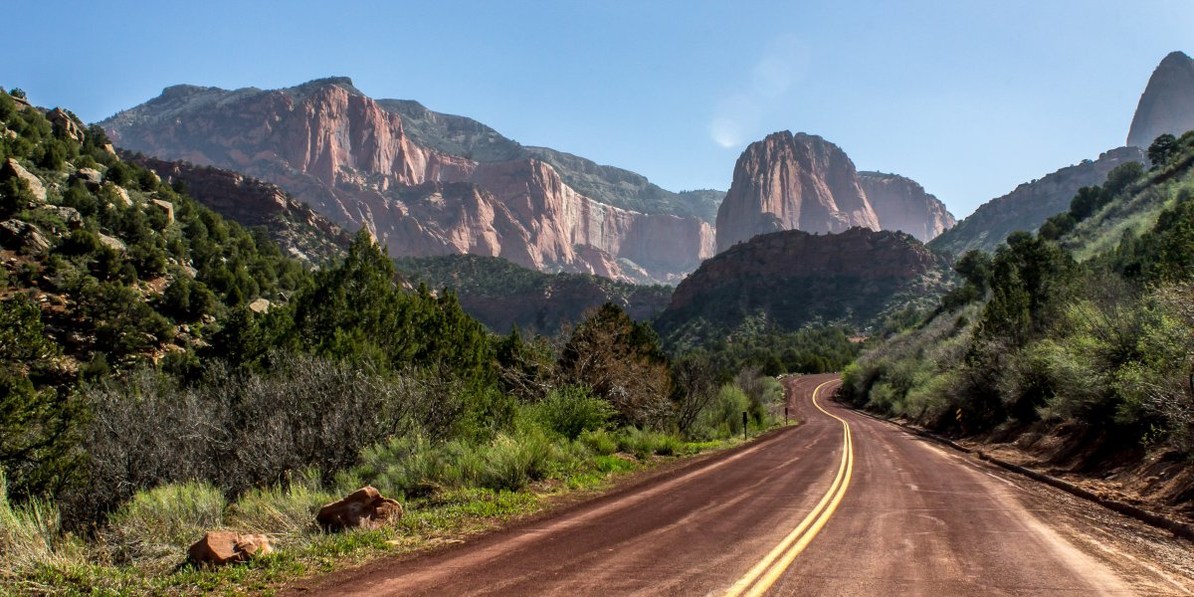
The beginning of the Kolob Canyon Scenic Drive. Photo by Denis Leblanc.
This northwest corner of the park receives much less attention than the main canyon, but the formations here are well worth exploring. From the park’s highest point at Horse Ranch Mountain (8,926 ft) to the magnificent Kolob Arch and the longer treks through La Verkin Creek and Hop Valley, Kolob is like a national park within a national park.
- Taylor Creek Trail Hike: 5-mile there-and-back featuring great creek and canyon views and a double arch feature.
- Kolob Canyon Viewpoint + Timber Creek Overlook Trail: A half-mile round-trip walk to incredible views that can extend to the Grand Canyon.
- Kolob Canyon via La Verkin Creek Trail: This route offers plenty of backcountry camping opportunities and stunning views from near La Verkin Creek.
- Trans Zion Trek: This phenomenal route across Zion starts from Kolob Canyon Road and finishes in Zion Canyon. This is a long and rewarding endeavor that requires planning and fitness, and it is also one of the most beautiful hikes in this national park.
- Kolob Arch via La Verkin Creek: While Kolob Arch itself is off limits, this 14-mile round-trip hike leads to excellent views of the second largest arch in the world.
Kolob Terrace Road accesses this western portion of the park dominated by the massive Tabernacle Dome, the North Guardian Angel, and the South Guardian Angel. The Left and Right forks of North Creek are home to some of the park’s most stunning canyon formations. Reaching some of these destinations requires technical skill, navigational expertise, and backcountry permits; other trips are easily undertaken for a day.
- North Guardian Angel Climb: At 7,395 feet, the summit of North Guardian Angel provides exquisite views of the Kolb Terrace. This is a technical climbing route that requires ropes and harnesses.
- Lower Subway: In contrast to the Upper Subway section, where rappelling is necessary, this is a straightforward and beautiful hike. Permits are required.
- Upper Subway: One of the most scenic and adventurous slot canyon hikes in Zion. This is a stunning, technical route that is very popular, so reserve a permit well ahead of time.
- Northgate Peaks Trail: Leaving from the Wildcat Trailhead, this trail offers some great backpacking opportunities through meadows and ponderosa pine forests as you progress up to Wildcat Canyon for unforgettable views. While there are no official campsites along this route, a Wilderness Permit is required for a multi-day trip.
Zion Canyon and Zion Narrows
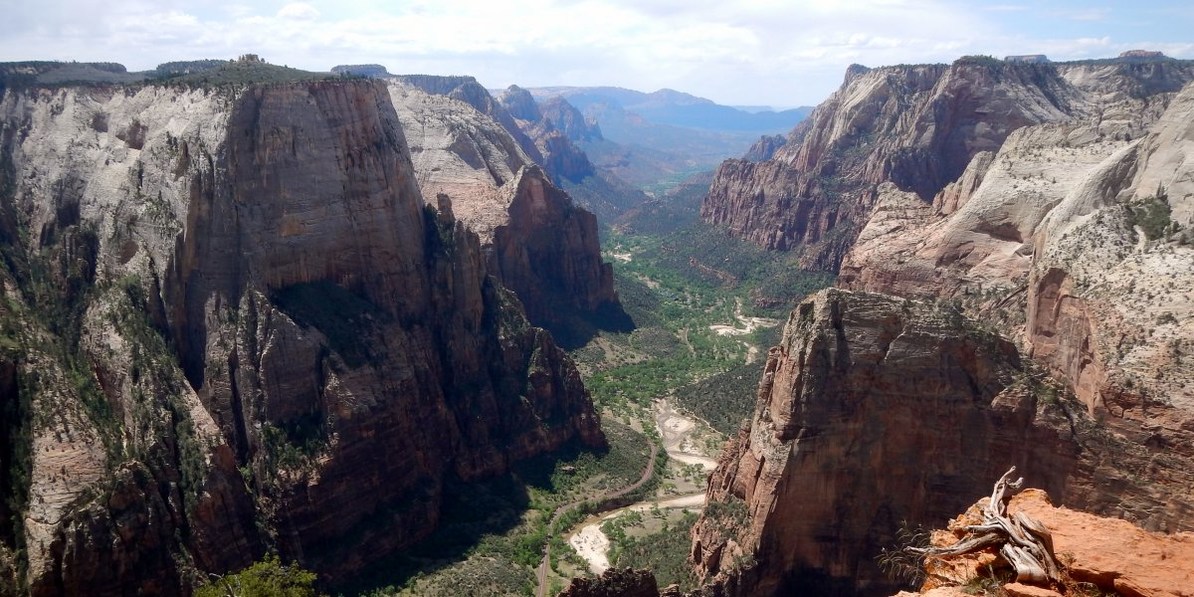
Views from Observation Point are breathtaking. Photo by Jessica Beauchemin.
This is the section of the park that receives the most attention, and it doesn’t disappoint. The Virgin River has created a masterpiece here, from the intimate sculpting in The Narrows to the broad expanse of Zion Canyon. There are incredible day hikes in this section of the park, so bring a pack, take the shuttle, and enjoy the heart of Zion National Park.
- West Rim Trail: This 14.5-mile trail begins on the high plateaus around Lava Point and descends through magnificent scenery into Zion Canyon.
- Angels Landing: Not for the acrophobic, this hike over a narrow cliff yields the park’s most majestic, unforgettable views of Zion Canyon. The total distance is 5 miles and there is almost 1,500 feet of elevation gain.
- Emerald Pools Trail Hike: This is a beautiful, family-friendly hike to a series of pools fed by graceful falls. Start from Zion Lodge or the Grotto. It's 3 miles round trip.
- Hidden Canyon Trail Hike: This hike is like a mini-Angels Landing; it is shorter, has less vertical gain, and still provides some of the cliff trail experience without the exposure. Beautiful views of Zion Canyon open up at the end.
- Observation Point: If there is a better view of Zion Canyon than from Angels Landing, this is it. Approximately 700 feet higher, Observation Point provides views that will leave you breathless. At 8 miles round trip, this is a longer walk, but there is significantly less vertical exposure along the way.
- The Narrows: One of the park’s most popular hikes, The Narrows can be accessed from the Temple of Sinawava as a straightforward there-and-back day hike or as a 16-mile thru-hike that requires a permit. Hiking is in the bed of the Virgin River, and the formations in this slot canyon are simply outstanding.
- Orderville Gulch: This hike is a great alternative to the popular Narrows hike. You'll want to arrange a shuttle, but the lighter crowds and stunning scenery will make this an unforgettable day in the canyon.
- East Rim Trail to Cable Mountain: This diverse hike begins at the bottom of the canyon and quickly ascends to Cable Mountain, so named for the cable system that transported lumber and other goods. The views of Zion Canyon and the East Canyon from this Cable Mountain are spectacular and well worth the 18-mile round-trip walk.
- Chinle Trail: In the far reaches of the park, this 15.4 mile there-and-back through the southern low elevation desert is a fantastic hike in cooler seasons when the sun is less intense or as a way to escape crowds in more popular areas of the park.
- Watchman Trail: This is a great hike for its brevity, its fantastic views, and its proximity to Watchman and South campgrounds.
Zion-Mount Carmel Highway and Upper East Canyons
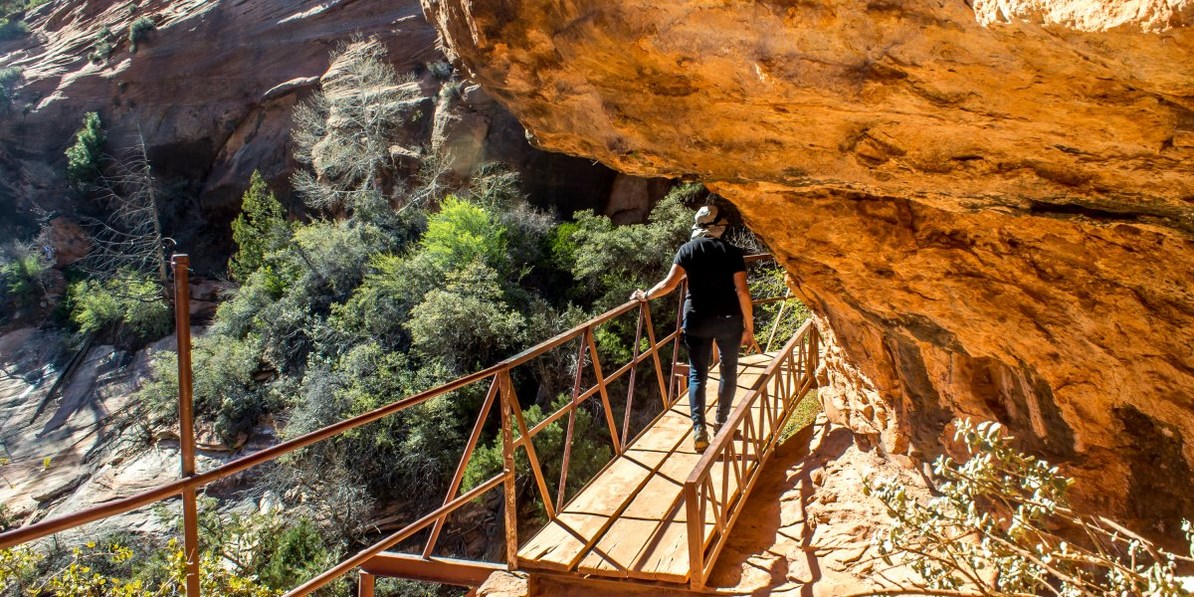
Canyon Overlook Trail, Zion National Park. Photo by Denis Leblanc.
The construction of the Zion-Mount Carmel Tunnel is a dramatic history in its own right. Thanks to this tunnel, visitors have direct access from Zion to Bryce Canyon National Park. Oversized vehicles must utilize a special permit, and two way traffic is stopped as large vehicles rumble through the space.
- Canyon Overlook Trail Hike: This trail is an excellent stop if you are driving along the Zion-Mount Carmel Highway. The round-trip hike is only a mile long, and the views along the trail alone are worth the walk down, not to mention tremendous views of Zion Canyon at the end.
- Clear Creek Hike: This non-technical slot canyon hike has easy access, and it is a great way to experience Zion’s Navajo sandstone up close without permits and gear. Park at the Canyon Overlook Trailhead to access this canyon.
- Petroglyph Canyon: Find this superb example of Native art close to the road. While the area isn't signed, it is easy to access and well worth the stop.
Camping and Lodging
There are only three campgrounds in Zion National Park, and only two within Zion Canyon. This means that first-come, first-served campsites are often entirely claimed early in the day, and the few sites that are available for reservation (in Watchman Campground) are often booked well in advance. Be sure to check out the variety of private campgrounds located outside the park, as you may be able to find a good alternative within an acceptable commute to the park. Check specific regions above for detailed information about the campgrounds in that area.
- Lava Point Campground: The campground has six primitive sites that are free and first-come, first-served. There is no water here, and vehicles longer than 19 feet are not allowed. It's normally open from June through October.
- South Campground: A good option for tent campers, this campground is near to the visitor center and the shuttle bus stop at the South Entrance. It's first-come, first-served, so be sure to arrive early to select your site.
- Watchman Campground: Also near the South Entrance, Watchman has sites with hookups, and some sites are available for reservation from March through November.
Lodging
Located south of the Narrows and next to the Virgin River, Zion Lodge offers year-round accommodation. A full service restaurant is open year round in addition to a seasonal cafe. Wi-Fi is available throughout the lodge. Pets are not permitted. Reservations can be made on their website or by calling 888.297.2757.
Additional lodging options abound outside of the park in Springdale, St. George, Toquerville, and Kanab.
Wilderness Reservations and Permits
All multi-day trips into the wilderness require a permit, whether you are backpacking into one camp, several camps, or undertaking a long climb with bivouacs. Technical canyoneering trips also require permits, as do trips through The Narrows and The Subway. Reservations for most of these permits can be made well in advance, and a fair number of permits are held for in-person applications the day before a trip.
Weather + Flash Floods
Fall is the ideal time of year to visit Zion. The scorching summer temperatures and unpredictable monsoons give way to a more consistent and comfortable weather pattern. Much of the park is unmaintained in winter, but if the year is mild, it can be a great time of year to see the park with fewer crowds. Highs are usually still near 60 degrees. Spring is filled with unpredictable weather, and water levels and wildflowers both peak in May.
Flash floods are a very real, very serious concern in Zion National Park. A recent event in 2015 killed seven hikers in Keyhole Canyon, and there are many more incidents to consider. The National Park Service works diligently to inform all hikers of the dangers of flash floods. Weather systems can quickly and dramatically change hiking conditions for the worse. Please check weather conditions, attend to park service warnings, and be flexible with your planned itinerary.
Shuttles
A well-run, efficient, and free shuttle system is the best transportation option within the park when crowds peak. From April to October, the Zion Canyon Scenic Drive is only open to shuttles and bikes. Shuttles in the park run every 10 minutes or so, meaning you can almost always catch a ride right when you need one. Additionally, frequent shuttles to and from the nearby town of Springdale also help ease traffic headaches. This means that you can park and stay outside of Zion and enjoy a hassle free commute with greater options for accommodation.
Pets
As is the case in most national parks, pets are prohibited on nearly all trails, in shuttles, or in public buildings. The Pa'rus Trail is a notable exception where leashed pets are allowed. Developed campgrounds, picnic areas, roads, and the grounds around Zion Lodge all permit pets on a leash. Any waste must be picked up immediately. If you are a pet owner who chooses to bring a pet to Zion, make sure to understand the weather forecast and be prepared for extreme temperatures that can take place in a car or tent on a hot day. If the weather is hot and you plan to be out exploring the park for much of the day, consider boarding your pet in Rockville, Hurricane, St. George, Kanab, or Cedar City.
Logistics + Planning
Current Weather: Powered by Dark Sky



























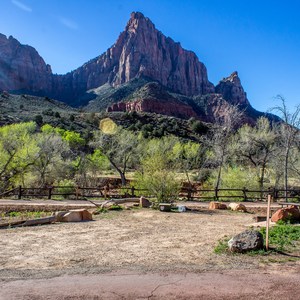



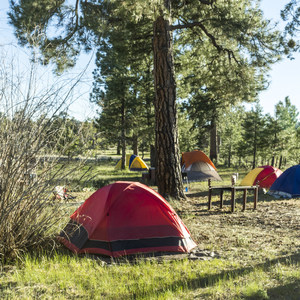



Comments
Sign In and share them.